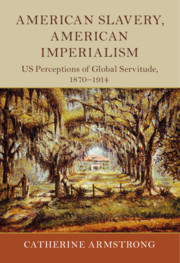Book contents
- American Slavery, American Imperialism
- Slaveries since Emancipation
- American Slavery, American Imperialism
- Copyright page
- Contents
- Figures
- Acknowledgements
- Introduction
- 1 A Rhetorical Continuum? How Representations of Antebellum Slavery Endure in Post-War Culture
- 2 Global Contexts: How External Factors Drive US Perceptions of Slavery
- 3 Othering the Slave Owner
- 4 Othering the Enslaved
- 5 Gender and the Rhetoric of Slavery
- 6 Resistance and the Slavery Counter-Narrative
- Conclusion
- Bibliography
- Index
6 - Resistance and the Slavery Counter-Narrative
Published online by Cambridge University Press: 17 August 2020
- American Slavery, American Imperialism
- Slaveries since Emancipation
- American Slavery, American Imperialism
- Copyright page
- Contents
- Figures
- Acknowledgements
- Introduction
- 1 A Rhetorical Continuum? How Representations of Antebellum Slavery Endure in Post-War Culture
- 2 Global Contexts: How External Factors Drive US Perceptions of Slavery
- 3 Othering the Slave Owner
- 4 Othering the Enslaved
- 5 Gender and the Rhetoric of Slavery
- 6 Resistance and the Slavery Counter-Narrative
- Conclusion
- Bibliography
- Index
Summary
This chapter examines the myriad ways that authors subverted the post-bellum slavery narrative - employing, variously, Marxist ideas, pan-Africanism and non-racially motivated anti-imperialist rhetoric. It shows that the rhetorical processes through which slaves and slave owners had been othered were challenged and an alternative vision of anti-slavery was offered.
- Type
- Chapter
- Information
- American Slavery, American ImperialismUS Perceptions of Global Servitude, 1870–1914, pp. 225 - 268Publisher: Cambridge University PressPrint publication year: 2020

